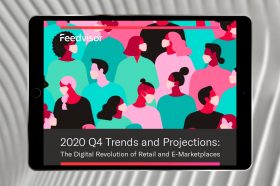Resources - Blog
4 Tips to Prepare Your Amazon Business for Prime Day 2020

Stay on top of the latest e-commerce and marketplace trends.
COVID-19 has changed buyer behavior practically overnight and highly disrupted the e-commerce landscape. Amazon delayed Prime Day this year due to the pandemic. An event traditionally scheduled in July will now be on Oct. 13 and Oct. 14, according to multiple sources.
Q4 is already expected to be more massive than ever before due to new e-marketplace conditions. Prime Day in Q4 is projected to accelerate holiday shopping and generate an even greater volume of online search traffic. Ensure your business is prepared by following these four tips.
1. Determine Appropriate Inventory Levels
Since holiday shopping is anticipated to begin early this year, the demand for consumer goods is high. However, it is important to determine which product categories to provide greater inventory for.
Brands and sellers can reference growth predictions for product categories to narrow down item selection. Keep in mind that many product categories must consist of “giftable” items to meet consumer needs during the holiday season.
Feedvisor data reveals projected sales growth across e-marketplaces for the following product categories in Q4:
- Clothing, Shoes and Jewelry: 72%–86%
- Electronics: 56%–69%
- Beauty and Personal Care: 19%–39%
Another factor to consider is data from previous Black Friday and Cyber Monday events. Since Prime Day is in Q4 this year, referencing past data from holiday shopping events can provide insight on how to allocate appropriate inventory levels for your items.
2. Utilize Direct Fulfillment on Amazon
Fulfillment is important in offering shoppers the maximum amount of items in your inventory. Brands and sellers who utilize Fulfillment by Amazon (FBA) often encounter difficulties with inventory receiving times. The receiving process, which previously took five days, can take up to 30 days to complete. The elongated process can significantly limit inventory available.
Amazon’s Direct Fulfillment program is beneficial for sellers to utilize as either a stand-alone fulfillment solution or a supplementary option to FBA.
Direct Fulfillment offers the following benefits:
- Leverage Entire Catalog: A seller can leverage their entire catalog to shoppers, which can increase sales by not being limited to third-party warehouse stockouts.
- Shows Item Availability Instantly: Amazon pulls inventory from electronic data interchange (EDI) in real time to show shoppers that a seller’s item is available for purchase.
- “Ships and Sold by Amazon” Feature: Items are displayed as “Ships and Sold” by Amazon, thereby establishing credibility.
- Access to Amazon’s Customer Service: Amazon handles customer service and returns on behalf of the seller.
- Amazon Pays for Shipping: Amazon pays for all of the shipping fees.
3. Price Competitively and Offer Bundles
Due to a myriad of brands and sellers participating in Prime Day to secure their share of holiday sales, competitive pricing and offering bundles is essential in maximizing profits.
Competitive pricing is key in standing out among your competitors. Amazon will be flooded with sellers who are providing discounted items on Prime Day. Strategically pricing items can drive traffic to your listings. Sellers can also invest in a repricing technology that adjusts the price of items to match market conditions in real time.
Offering consumers product bundles is not only ideal for generating more sales but also in moving inventory. Bundles can drive sales of multiple items in your catalog. It is best practice to create bundles with items that are frequently purchased together. Sellers can get ideas of which items to pair from Amazon’s product recommendations.
4. Optimize Marketing and Advertising Strategies
Brands and sellers must optimize their marketing and advertising strategies in order to drive more traffic to their listings on Prime Day. This will help you not only nurture existing customers but also acquire new customers.
Marketing campaigns are a great way to showcase your brand story and value proposition. Differentiation from competitors can make all the difference when shoppers are selecting an item between brands. Leveraging social media as part of your marketing plan will also assist in conveying your brand’s positioning and Prime Day deals to a wider audience.
Implementing a full-funnel advertising strategy can help you capture more leads by reaching consumers throughout their buyer journey. Amazon DSP can assist with top-funnel efforts by displaying ads across platforms to consumers who viewed related items that your brand sells on Amazon. Offering additional discounts to qualified leads in your advertising campaigns is a great bottom-funnel tactic that can increase conversions.
Final Thoughts
Prime Day is quickly approaching. Since Prime Day is in Q4 this year, brands and sellers must adopt new strategies to adhere to the massive online traffic expected from early holiday shopping. The event’s new date presents sellers with both opportunities and challenges.
Evaluating the current e-commerce landscape and referencing data from previous Q4 holiday shopping events is a good starting point. Implement all of the tips provided to maximize your sales during a Q4 that is expected to be the most disruptive to date.
Learn what Feedvisor can do for your business.
When you partner with Feedvisor, you automatically receive access to our true, AI-driven technology and hands-on team of e-commerce experts. Contact one of our team members today to learn more about our end-to-end solution for brands and large sellers on Amazon, Walmart, and e-marketplaces.




